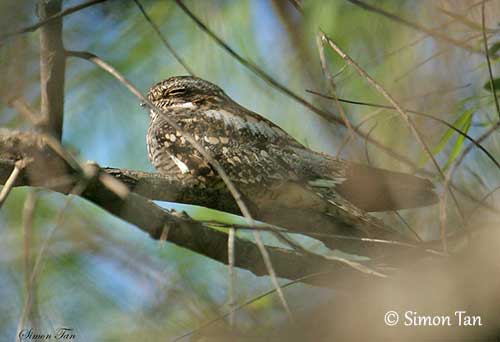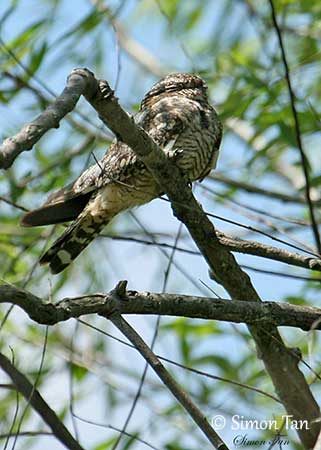
Fr: Engoulevent d'Amérique
Ang: Common Nighthawk
All: Falkennachtschwalbe
Esp: Añapero Yanqui
Ita: Succiacapre sparviere
Nd: Amerikaanse Nachtzwaluw
Sd: större falknattskärra
Photographers:
Ken Havard
My Bird Gallery & Flickr gallery 1 & Flickr gallery 2
Patrick Ingremeau
TAMANDUA
Simon Tan
PBase Bird galleries
Text by Nicole Bouglouan
Sources:
HANDBOOK OF THE BIRDS OF THE WORLD Vol 5 by Josep del Hoyo-Andrew Elliott-Jordi Sargatal - Lynx Edicions - ISBN: 8487334253
NIGHTJARS - A Guide to Nightjars and Related Nightbirds – Nigel Cleere and Dave Nurney - Yale University Press - First Edition (August 11, 1998) - ISBN 10: 0300074573 / ISBN 13: 9780300074574
Animal Diversity Web (University of Michigan Museum of Zoology)
All About Birds (Cornell Lab of Ornithology)
The Birds of North America online
Neotropical Birds – Cornell Lab of Ornithology
What Bird-The ultimate Bird Guide (Mitchell Waite)
Bird Web (Seattle Audubon Society)
Wikipedia, the free encyclopaedia
Common Nighthawk
Chordeiles minor
Caprimulgiformes Order – Caprimulgidae Family
INTRODUCTION:
The Common Nighthawk is a medium-sized bird with very cryptic plumage, as usual in nighthawks. It is a member of the subfamily Chordeilinae, limited to the New World. These species lack the rictal bristles typical of the subfamily Caprimulginae.
The Common Nighthawk occurs in North and Central America where it breeds, but it winters in South America. Nine subspecies share the large range.
It frequents forests, deserts, savannahs, beach and desert scrub, prairies, and even cities, from sea-level to 2,600 metres of elevation. This species feeds on various flying insects caught in flight. The pair forms following spectacular aerial displays. They usually are solitary nesters, although they may sometimes breed in loose groups. Both parents share most of nesting duties.
The Common Nighthawk is described as common and widespread throughout the breeding range. However, the population is declining in many parts of North America.
DESCRIPTION OF THE BIRD:
Biometrics:
Length: 22-25 cm
Weight: 65-98 g
The Common Nighthawk adult male has very cryptic plumage with brown to blackish brown upperparts showing greyish-white, buff and cinnamon spots and speckles. The nape is spotted buff, but there is no nuchal collar.
On the upperwings, the lesser coverts are dark brown and slightly spotted like the upperparts. The other wing-coverts are brown, also with paler spots and speckles. There is often some white on the lower marginal coverts. The scapulars are brown and spotted buff. At rest, the long, slender and pointed wings extend beyond the tip of the tail.

The underparts are brown with pale grey barring, whereas belly and flanks are mostly greyish-white, washed buff and barred brown. On the underwing, the male has the five outermost primaries crossed by a broad, white band. On the undertail, the rectrices show a white subterminal band except on the central pair. The tail is forked.
The head is small. The crown is dark brown with buff to tawny spotting. The supercilium is greyish-white and the throat patch is white.
The small bill is blackish. The eyes are dark brown. Legs and feet are brownish.
The female has buffish throat patch and buffier underparts than male. She has less distinct and thinner white bands on the wings, and she lacks the white on the tail.
The immature resembles adult but it has more heavily barred underparts, the throat patch is paler and spotted. The white tail band is absent, whereas all primaries and secondaries are finely tipped white.
SUBSPECIES AND RANGE:
The Common Nighthawk has nine subspecies that vary in size, coloration, barring on the underparts and extent of white on both wings and tail, especially in males.
C.m. minor (described above) is found in most C and S Canada, S to N and NE USA.
C.m. hesperis is found in SW Canada and W USA.
C.m. sennetti occurs in CS Canada and NC USA.
C.m. howelli is found in WC and SC USA.
C.m. henryi occurs in SW USA and CN Mexico.
C.m. chapmani is found in SE USA (E Texas to South Carolina and S to Florida)
C.m. aserriensis occurs in extreme S USA (S Texas) and NE Mexico (S to N Veracruz).
C.m. neotropicalis is found in E and S Mexico (S from S Veracruz) S to Guatemala and W Honduras.
C.m. panamensis occurs in Nicaragua S to Panama, and possibly N to E Honduras and Belize.
All subspecies winter in N and E South America.
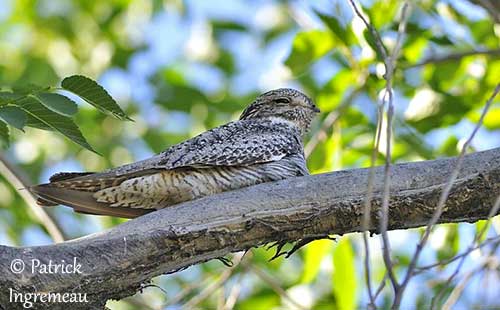
HABITAT:
The Common Nighthawk is usually found in open country and can be seen flying over cities and towns. It frequents various types of open and semi-open areas such as forest clearings, open pine woods, barren hillsides, open grasslands, farmland, pastures, gravely ridges, suburbs and even cities centres. It can be seen from sea-level to 2,600 metres of elevation.
CALLS AND SONGS: SOUNDS BY XENO-CANTO
The Common Nighthawk communicates by calls and displays. It calls all year round, but mainly at dusk and dawn, by day and occasionally at night.
The males gives a nasal “peent” as territorial or courtship call, usually while flying, but also sometimes from perch or from the ground. Guttural croaking sounds can be heard prior to copulation during the “throat-puffing” display.
A rapid series of calls is given during aerial pursuits “kit-kit-kit-kit-kit” or “yap-yap-yap-yap” notes. The alarm call is a repeated “che-wip”, also given when the bird is flushed.
At nest, the male produces guttural, croaking “awk awk awk” notes or growling sounds, and the female replies with guttural “kra-a” notes. In defence displays or if the nest is threatened, the female produces a guttural hissing.
Non-vocal sounds are used too, such as the booming sound made by the primary feathers of males during the courtship displays to communicate.
BEHAVIOUR IN THE WILD:
The Common Nighthawk feeds on various insects such as beetles, moths, grasshoppers and numerous other species. It often feeds on swarms of winged ants or termites.
It forages mainly around dusk and dawn, but also during the day in lowlight conditions and at night, especially on moonlit nights.
It uses its large mouth to hawk insects in flight, and its large eyes allow the bird to find prey in the darkness. In urban areas, it flies around the streetlights and catches insects attracted to these lights. It rarely takes insects from the ground.
This species drinks in flight by skimming the water surface with the bill, especially with the lower mandible.
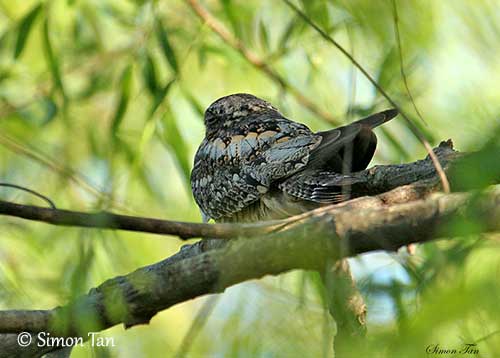
At the beginning of the breeding season, the male performs courtship displays to attract a female. It displays both on the ground and in flight. During the aerial displays, the male flies in circles and hovers high in the air. The wingbeats become more stiff and active while the flight is progressing, and it gives repeated calls.
Then, it performs a steep dive while the wing feathers produce a rushing or booming sound when the air passes through the feathers, especially at the end of the dive.
It lands close to the female and then, it fans the tail while rocking back and forth, and calls. During this display, the white throat patch is exposed by puffing out the white feathers while the male produces a croaking noise.
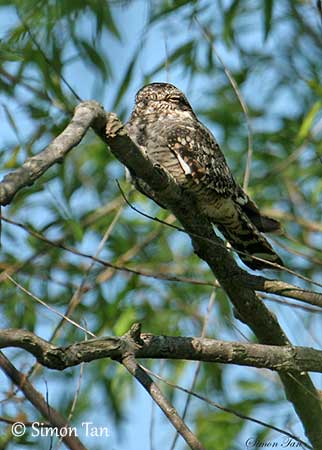
The Common Nighthawk is highly migratory. They migrate in loose flocks of 20-40 individuals, with large numbers travelling along favourite routes. They often wave while flying. In autumn, flocks of up to 1,000 birds are not uncommon.
The birds of the nominate race leave the breeding areas from late July to early October, with peak between mid-August and early September, and they move S through Central America. They winter in South America E of the Andes, as far as N Argentina. In spring, they arrive on the breeding grounds from late April to late May.
Vagrants are recorded in Iceland, Faeroes, Britain, at sea near Azores and on Tristan da Cunha (in autumn).
The Common Nighthawk is very agile in flight and performs slow, steady wingbeats. The flight is direct on long pointed wings, with erratic twists and turns and changes of direction. It can interrupt the normal flight by fanning its tail abruptly, so the bird briefly hangs in the air between the wingbeats.
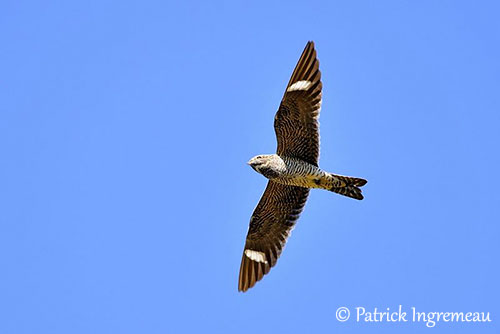
REPRODUCTION OF THIS SPECIES:
The breeding season varies depending on the range with May-July in Canada, late April to August in N USA, late March to August in S USA and mid-May to August in Central America.
The Common Nighthawk is territorial and chases between males often occur. They may breed in loose flocks where suitable nesting sites are reduced, but they are usually solitary nesters.
The nest-site is on the ground or bare open soil, usually on sandy place or gravel roofs, or on top of a raised structure or a stump. No nest is built. The eggs are laid on the ground, directly on the leaf-litter, on sand, pine needles, rock, moss or lichens. The site is chosen by the female.
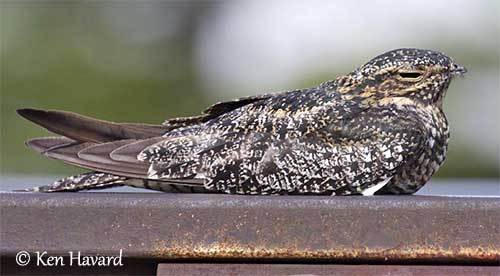
The female lays 1-3, usually 2 whitish, pale buff or grey eggs with numerous brown spots. They are very cryptically coloured. She incubates during about 19 days. The adults may perform defence and/or distraction displays if the nest is threatened, like the “broken wing” display.
At hatching, the chicks have grey and buff down with darker blotches. They are fed by regurgitation of insects by both parents. They are semi-precocial and perform their first flight about 3 weeks after hatching. They are independent at 25 days. This species usually raises a single brood per season, rarely two.
PROTECTION / THREATS / STATUS:
The Common Nighthawk is suspected to be declining seriously in many parts of North America. Declines are caused by changes in land use and use of pesticides. They are affected by increasing urban populations of Corvidae which eat the eggs when they nest on gravel roofs.
However, the Common Nighthawk is described as widespread and generally common throughout the breeding range, and as widespread on South American wintering grounds.
The main predators on the wintering areas are the American Crow, the Peregrine Falcon, the American Kestrel, the Laridae (genus Larus), the owls (Strigidae), and coyotes, foxes, skunks, snakes, dogs and cats.
But the Common Nighthawk is not considered globally threatened and is currently evaluated as Least Concern.
